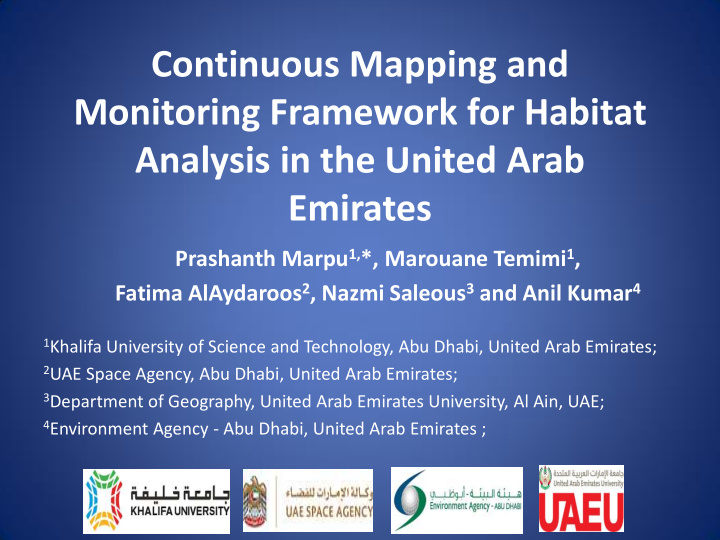



Continuous Mapping and Monitoring Framework for Habitat Analysis in the United Arab Emirates Prashanth Marpu 1, *, Marouane Temimi 1 , Fatima AlAydaroos 2 , Nazmi Saleous 3 and Anil Kumar 4 1 Khalifa University of Science and Technology, Abu Dhabi, United Arab Emirates; 2 UAE Space Agency, Abu Dhabi, United Arab Emirates; 3 Department of Geography, United Arab Emirates University, Al Ain, UAE; 4 Environment Agency - Abu Dhabi, United Arab Emirates ;
Outline • Introduction • Habitat mapping in UAE • Proposed Work • Data and Results • Future Work
Introduction • United Arab Emirates (UAE) has seen a tremendous growth in the last decades developing advanced urban centers in the world e.g., Abu Dhabi and Dubai • Rapid development can put the environment under significant stress • Need for continuous monitoring of the landcover and landuse to make informed decisions • Environment Agency- Abu Dhabi (EAD) has developed a detailed Habitat, Land Use, Land Cover Map based on very high resolution satellite imagery acquired between 2011 and 2013 for the Abu Dhabi Emirate.
Habitat mapping in the UAE • First comprehensive mapping exercise: 2013 A total land area of 60,000 km 2 and a marine area of 30,000 km 2 has been mapped at 1:10,000 scale with an accuracy of around 87% on an average. A total of 54 different natural and man-made mapping categories at a very fine level of detail, with 41 terrestrial and 13 marine habitat categories. The map serves as a baseline to assess the state of fragile habitats in Abu Dhabi Emirate. WorldView-2 and RapidEye satellite data were used for the generation of the maps. https://www.ead.ae/Publications/Abu%20Dhabi%20Habitat%20Mapping%202016/Habitat%20Book%2 0English%20Web.pdf
EAD Habitat Classification Codes
Habitat Mapping in the UAE • Banking on the effort of the EAD, there is an ongoing effort to extend the process to cover the entire UAE with key stakeholders like UAE Space Agency and Ministry of Climate Change and Environment leading the initiative. • The aim is to generate a highly detailed classification with over 55 classes and at a spatial resolution of less than 5 m for the entire country. • The work also aims to develop a methodology to perform updates to the maps in short intervals of less than 2 years as against 5-6 years which is normally accepted globally. • In the first phase, four areas are considered for the development and validation of the methods.
Proposed Work • Two approaches are considered to generate the land use, land cover maps. Segmentation-based classification Convolutional Neural Network based advanced classification
Segmentation-based classification
CNN-based classification
CNN-based classification • AlexNet framework is used in this work.
CNN-based classification • We use an approach of ‘Ensemble of Random Forests’ to classify the features (i.e. 4096 FC7 features) generated from AlexNet framework. • Multiple Random Forests are employed to with around 20% sampling of the available training data and a majority voting is performed to decide the final class at every pixel.
Data Images acquired by WorldView-2 satellite are used in this work at the four locations indicated in the figure. The final spatial resolution is 0.5 m after pan-sharpening
Results • Segmentation based approach Image Proposed Method EAD Map Accuracy = 84%
CNN Approach Average accuracy > 92%
Conclusions • Two methods are developed as an attempt to generate classification maps to replicate the earlier work in the emirate of Abu Dhabi at four randomly selected sites. • The CNN-based approach has shown great potential in producing relatively high accuracy maps in comparison to the segmentation based approach. • We are currently extending this work to cover entire Abu Dhabi emirate in the first phase which will be extended to the other emirates after updating the classification codes to integrate class definitions from other habitat classes
Recommend
More recommend